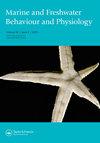当近邻成为好朋友:形成单一和混合物种群体的同域鱼类行为特征的可塑性
IF 0.9
4区 生物学
Q3 MARINE & FRESHWATER BIOLOGY
Marine and Freshwater Behaviour and Physiology
Pub Date : 2019-01-02
DOI:10.1080/10236244.2019.1624168
引用次数: 3
摘要
与单物种鱼类群体一样,混合物种组合的形成可能是由营养影响和种间行为特征驱动的。我们的目的是确定不同表型的同域河口物种如何形成混合物种群体关联,并确定在单一和混合物种群体之间迁移的鱼类群体结构的变化。我们使用同地分布的黄眼鲻鱼(Aldrichetta forsteri)、卡哈伊鱼(Arripis trutta)和澳大利亚鲷鱼(Chrysophrys auratus)作为混合种组的不同表型,黄眼鲻鱼作为单种和混合种组的比较。对捕食组和觅食组的群体形成和结构进行量化。我们利用以往对单物种黄眼鲻鱼的研究,将其行为可塑性与当前的研究进行比较。我们的新结果表明,在单一和混合物种的鱼类群体中,相似的行为特征有益地共同进化,重要的是,行为可塑性对于群体之间的迁移是必要的。总的来说,我们的观察强调了与河口生态系统中混合物种鱼类形成相关的关键行为反应。本文章由计算机程序翻译,如有差异,请以英文原文为准。
When close neighbours become good friends: plasticity of behavioural traits in sympatric fishes that form mono- and mixed-species groups
ABSTRACT Like mono-species fish groups, formation of mixed-species assemblages is likely driven by trophic influences and interspecific behavioural traits. Our aim was to identify how sympatric estuarine species of differing phenotypes form mixed-species group associations, and to identify changes to group structure of fish that migrate between mono- and mixed-species groups. We used sympatric yellow-eyed mullet (Aldrichetta forsteri), kahawai (Arripis trutta), and Australian snapper (Chrysophrys auratus), representing different phenotypes for the mixed-species group, and yellow-eyed mullet for the mono- and mixed-species comparison. Group formation and structure was quantified in predator and foraging treatment groups. We used previous research in mono-species yellow-eyed mullet to compare behavioural plasticity with the current study. Our novel results suggest similar behavioural traits in mono- and mixed-species fish groups have beneficially co-evolved and importantly, behavioural plasticity is necessary for migration between groups. Overall, our observations highlight key behavioural responses associated with mixed-species fish formations in estuarine ecosystems.
求助全文
通过发布文献求助,成功后即可免费获取论文全文。
去求助
来源期刊

Marine and Freshwater Behaviour and Physiology
生物-海洋与淡水生物学
CiteScore
2.10
自引率
0.00%
发文量
9
审稿时长
>12 weeks
期刊介绍:
Marine and Freshwater Behaviour and Physiology is devoted to the publication of papers covering field and laboratory research into all aspects of the behaviour and physiology of all marine and freshwater animals within the contexts of ecology, evolution and conservation.
As the living resources of the world’s oceans, rivers and lakes are attracting increasing attention as food sources for humans and for their role in global ecology, the journal will also publish the results of research in the areas of fisheries biology and technology where the behaviour and physiology described have clear links to the contexts mentioned above.
The journal will accept for publication Research Articles, Reviews, Rapid Communications and Technical Notes (see Instructions for authors for details). In addition, Editorials, Opinions and Book Reviews (invited and suggested) will also occasionally be published. Suggestions to the Editor-In-Chief for Special Issues are encouraged and will be considered on an ad hoc basis.
With the goal of supporting early career researchers, the journal particularly invites submissions from graduate students and post-doctoral researchers. In addition to recognising the time constraints and logistical limitations their research often faces, and their particular need for a prompt review process, accepted articles by such researchers will be given prominence within the journal (see Instructions for authors for details).
 求助内容:
求助内容: 应助结果提醒方式:
应助结果提醒方式:


